In early August, I visited the American Precision Museum in Vermont, which is dedicated to the history of the American machine tool industry, and also made a side trip to the Simon Pearce Glass facility, recommended by Mike Kennedy in comments not too long ago. Images (should expand when clicked) from upper left…
1–The museum is located in the former Robbins & Lawrence armory. Power was initially from a waterwheel, later supplemented by steam
2–Blanchard Copying Lathe. Mechanically copies a prototype shape…a rifle stock, in the example shown, but also used for table and chair legs, etc
3–A much later approach to automated cutting of a specified shape: this is a paper tape reader used to feed data to a numerically-controlled machine tool.
4–Bendix G-15 computer, from the mid-1950s. This one was used for gear-cutting calculations, reducing the typical time taken from 2 hours to 2 minutes. Computers of this type were also used to directly produce the punched paper tapes used to operate machine tools.
5–Sewing machine from 1859. The success of these devices created great demand for precision machining.
6–A very elaborate model of a steam engine, made by a German man who came to the US between the wars. When he visited Germany in the 1950s, he found that the model had survived intact in an attic.
7–Profile milling machine, for cutting the outside periphery of a flat surface.
8–Columbia chainless bicycle, from the 1890s. An advantage of this type was that women could ride them without danger of getting their long skirts caught in a chain. A disadvantage was the price…$125 in 1890 dollars!
9–Bevel gear cutting machine…made gears of a type required for the chainless bicycle. Not clear if this machine came before the Columbia bicycle or if it was a later production-cost improvement.
10–The showroom at Simon Pearce glass.
11 & 12–Hydroelectric dam and turbine used to generate power at Simon Pearce. Capacity is about 600KW, and what they don’t use for their own needs (which are pretty significant given the electric glass-heating furnaces) is sold to the grid.
Lots more pictures of Simon Pearce at this article.
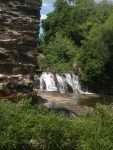
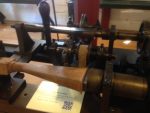
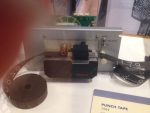


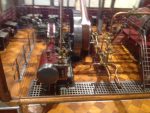
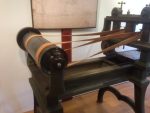
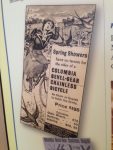
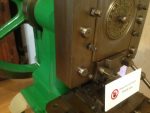


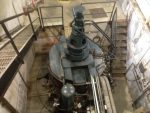
I hope you had the chance for dinner at Simon Pearce>
It is the best restaurant near Dartmouth.
Not hungry at the time, Mike, so didn’t eat there. Dinner at Jesse’s Steakhouse, which was pretty good…nice outdoor patio.
8–Columbia chainless bicycle, from the 1890s. An advantage of this type was that women could ride them without danger of getting their long skirts caught in a chain. A disadvantage was the price…$125 in 1890 dollars!
Shaft-driven bikes are still being made. €1000 vs. $3000 in today’s dollars for that 1890 bike.
I have a Wheeler & Wilson W9 machine that belonged to my great grandmother and with which she made her children’s clothes. She had 12 children, nine boys, so it was put to good use.
If you find yourself in Huntington WV a visit to Blenko Glass should be on the agenda. Quite a showroom, too.
http://www.blenko.com/
Ah, an octal paper tape reader.
I was hoping to never see one of those again. When I started in CNC equipment (it was then just NC, not Computer Numerical Control), they were basically the bane of my life. The mechanical versions had little metal ‘fingers’ that sensed the holes in the tape. After cycling the tape a number of times, what with production and all, the the fingers would start to elongate the holes, eventually leading to read errors, and usually a wreck of some kind.
The optical ones started coming out early 70’s, and were much faster and more reliable. Until some moisture or oil managed to get on the tape, and it would become essentially transparent, and the little lights could ‘see’ through the tape, leading to more of the aforementioned loud events. The only full solution was to punch the tape in mylar, which was durable, secure, and relatively expensive. So you better hope that you got the programming right coming out of the gate, or you were going to use up a lot of mylar.
I was sooo glad when they (1) started putting memory in the controls, and (2) stopped using hydraulics to drive the machinery, the downside of which was, if there was a power glitch, the machine would basically lose it’s mind, while it’s muscle would go off in whatever direction it felt like until the pressure bled off.
The most important thing to know about any machine is where the emergency stop button is; usually the large, red button.
Ed, how long were the tapes typically?…Must have been a lot of variance depending on what part was being made, but do you remember the general range and any extreme example? Just curious
“an octal paper tape reader.”
Isn;t that how Gates and Allen got started ?
With traffic monitors ?
Paper tape technology was originally developed for use in telegraph/teleprinter systems, and was adapted by early computer manufacturers…less-so in the case of IBM given their heavy commitment to punched cards.
Probably the ultimate paper tape application was for the British ‘Colossus’ codebreaking machine, in which messages to be analyzed were punched on tape, which was then glued into a continuous loop for repetitive electronic analysis. The tape was read at something like 5000 characters per second.
A short video on Colossus, including the fast paper tape loop.
While understandable given the extreme secrecy, it really is a pity that Tommy Flowers and his team never got due credit for their remarkable contributions to the war effort and the development of technology.
Been busy today. The refineries are coming back on line, and most have shutdown /turnaround scheduled, so the loud voices are screaming for parts.
Anyway.
BTW, they are called Octal tapes because they have eight rows of data holes, and one row of drive sprocket holes. The drive holes are offset one row to one side so the tapes can only be loaded one way.
Most of the tapes were in the 50 to 75 foot range. Which made the roll about 4″ in diameter, allowing for ~2″ open in the middle of the roll to fit on the reel. We sometimes ran the tapes loose in the console, if it was a shorter tape. We frequently had programs that were much longer, and eventually found out that using a series of shorter tapes, and changing them in sequence, was a useful strategy in case of tape error. Make the original tape, test run it in the shop, take the original back and make a copy for production. Original never leaves the office again once proven out.
The programming system was originated by General Electric; they eventually offshored the operation and created the Japanese corporation Fanuc, with is the largest maker of these in the world, who then licensed and offshored their own operation. The language goes by the generic name ‘G-code’. If you operate one of the more sophisticated controls around (Mazak Integrex, Okuma, Heidenhain, and Siemens) and open the screen background control windows, G-code is happily running in the background, actually telling the machine what to do. The advanced stuff you see running writes the G-code, and it executes it in the background. Kinda like DOS.
Until quite recently, when you asked a Fanuc console about available memory, the answer would come back in ‘feet’ rather than kbytes. You can guess where that came from.
You also need to bear in mind that all of this was engineered completely apart from PCs. It’s only been in the last 30 years or so that machine tools have had actual PC components in them. They were designed and built out of industrial electronic components, and parts, say maybe replacement boards, were hideously expensive. I’m talking 30 years ago, $15G for a display drive board. (And the numeric display in question was what’s referred to as ‘Nixie Tubes’. Look it up if you want you mind blown.)
Thanks for this. These are about an hour away but I have never been to either. There’s lots to do in the area. King Arthur’s Flour, Norwich University (military), covered bridges, art museums at the college and craftsmen galore, Harpoon brewery, St Gaudens Historical, Queechee Gorge. Plus the mountains and hiking – the AT goes right through there.
I warn you though, that Hanover! is disliked by the surrounding towns for good reason. Though if you aren’t there long it won’t affect you much.